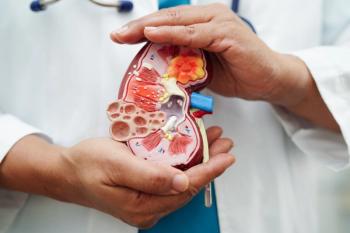
Circadian Disruption May Be Significantly Linked to Chronic Kidney Disease
Increased waist circumference and high blood pressure can disrupt circadian rhythm, which can increase risk of progression to poor renal outcomes.
Circadian syndrome (CircS) can significantly increase risk of chronic kidney disease (CKD) in middle- and older aged adults, according to the authors of a recent cross-sectional and longitudinal study published in The Journal of Nutrition, Health, and Aging.
Circadian rhythm disruption is linked to various chronic diseases. With CircS, the condition is described as including 4 of 7 traits that increase risk of chronic disease, which include: increased waist circumference, elevated triglycerides level, reduced high-density lipoprotein-cholesterol (HDL-C) level, high blood pressure (BP), elevated fasting glucose level, short sleep duration, and depressive symptoms, according to the study authors.
Since most studies have evaluated the link between CircS and cardiovascular diseases, this study aims to analyze the impact of CircS on kidney outcomes. Data were originally collected from 6002 adults aged 40 years or older who participated in the 2011 China Health and Retirement Longitudinal Study. Data also comes from a 2015 follow-up of 3670 participants.
The study’s primary outcome was the development of CKD—characterized by an estimated glomerular filtration rate (eGFR) that is less than 60 ml/min/1.73 m2. It’s worth noting that the glomerular filtration rate has a circadian rhythm which—when out of balance—can cause conditions such as CKD. The secondary outcome was rapid decline in renal function, defined as annual eGFR reduction of 5 ml/min/1.73 m2.
Investigators observed a strong link between CircS and the prevalence of CKD and rapid decline in renal function (both in 2011 and at follow-up) compared to patients who did not have CircS.
In addition, having 6 CircS components was associated with greater risk of rapid decline in kidney function compared to 4 CircS components; thus, “as the number of CircS components increased, the incidence of rapid decline in kidney function also increased,” study authors wrote.
In a subgroup analysis, increased waist circumference, elevated triglyceride level, increased BP, and reduced HDL-C level were more likely to be associated with progression to CKD. Investigators also looked at sleep duration, where they found that less than 6 hours of sleep/day was associated with increased risk of progression to CKD.
Traditionally, a person’s circadian rhythm is regulated by an internal circadian clock system. Certain genes regulate this circadian clock; thus, these genes regulate the circadian rhythms of varying cells and organs.
The kidney has a strong circadian rhythm. This means that, if it does not have optimal circadian rhythm activity, there could be physiological consequences, and the kidneys may develop pathologic disease.
The authors noted that the study contains some limitations. First, the data come from self-reported questionnaires, and answers may be prone to subjectivity. Other limitations include short follow-up that did not include all participants, possible missed confounding factors, and the limited generalizability of findings.
Regular routines, appropriate sleep patterns, and reduced night shift work and artificial light exposure can help to restore circadian rhythm function, according to authors. There are also measures that can reduce risk of CKD, which can include maintaining healthy BP and glucose levels, waist circumference, and psychological counseling.
“Early identification of individuals at high risk for CircS is crucial in implementing timely behavioral interventions to prevent the onset of CKD,” wrote the study authors.
REFERENCE
Ran J, Tao C, Zhang S, et al. Circadian syndrome is associated with the development of chronic kidney disease and rapid decline in kidney function in middle-aged and elder adults: a China nationwide cohort study. The Journal of Nutrition, Health, and Aging. 2024;doi: 10.1016/j.jnha.2023.100011.
Newsletter
Stay informed on drug updates, treatment guidelines, and pharmacy practice trends—subscribe to Pharmacy Times for weekly clinical insights.



















































































































































































































